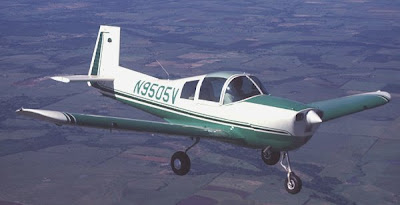The AG-14 has an interesting history. It was designed by Marvin Greenwood, who was Assistant Chief Engineer on the B-29 project, and who later designed what came to be known as the Bellanca T-250 Aries (below).
Though the AG-14 was a full three-control aircraft (only one rudder; it was on the left fin and wasn't very effective), ground steering was controlled by the wheel instead of the rudder pedals. And a third pedal, to the right of the rudders, applied brakes to both mains simultaneously -- no differential braking. This unusual control arrangement made crosswind operations something of a challenge.
Cessna engineers were intrigued by the AG-14's configuration. Cessna's former Manager of Aerodynamics and Flight Test, Bill Thompson, wrote,
"[W]e had run an extensive flight test on a rented Anderson-Greenwood AG-14 2-place pusher airplane in the early 1950s, but it was a great disappointment. Consequently, it was decided to design and build an Experimental Magic Carpet (XMC) prototype with no plans for eventual production in that exact configuration. The objectives were to overcome the flying qualities deficiencies of the AG-14, achieve much lower noise levels, and, if possible, find lower-cost construction methods."
Cessna's project addressed some of the problems inherent in a twin-boom pusher in this class, e.g., interior noise; control circuit complexity and friction; and crashworthiness (minimal structure ahead; heavy engine behind coming through the cabin in severe deceleration).
Barry Schiff's book
Dream Aircraft has a chapter on the AG-14, with a full pilot report.
















